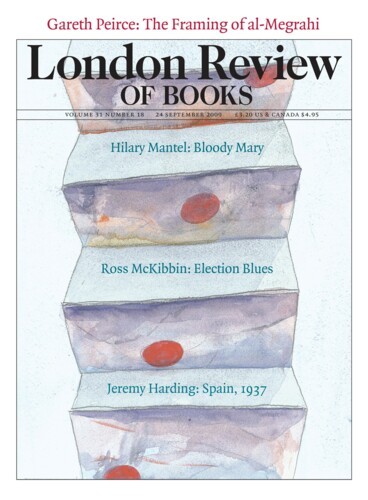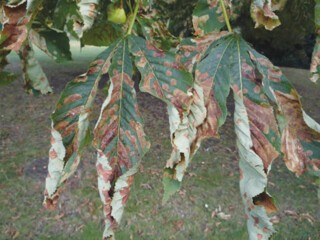What I did on my holidays. Twice in the summer I went to France, to La Sauvetat in the South-West and Mourjou in the Auvergne, and once in the spring to Italy, to Santa Cristina in Umbria, not far from Orvieto. Agriculture is, for visitors, a spectator sport. To offer a commentary on land management would be impertinent. But I was there for the views and allow myself opinions about how land use affects the look of things.
All three are agricultural villages, surrounded by a patchwork of fields. In La Sauvetat they are mainly planted with corn, sunflowers and maize. There is some millet, a little grazing and rearing of ducks and, within walking distance, a piece of managed woodland. Santa Cristina has vineyards as well and once in a while (they seem to be mostly herded into barns) you see Chianina cattle, as white as the bull in Claude Lorrain’s Rape of Europa. Mourjou is mainly cow pasture and fodder crops. The livestock there, too, is handsome: dark red-brown Salers cows, each herd with its pale Charolais bull and buff calves. In both Mourjou and Santa Cristina the fields run to the edge of steep valleys and gullies. Look at the fields in all three places and you realise how agriculture (unlike gardening) limits the number of species that land carries. It is in the divisions between fields, alongside roads and in land too steep to cultivate that variety is found. If the fields are the fabric of the patchwork, the hedges, ditches and embankments are the narrow stitched edges and broader borders of the quilt.
It is in these seams between cultivated fields that opportunistic vegetation – weeds, wild flowers, escapees from gardens – breaks through and flourishes. Round La Sauvetat there is not much of it. Tractors with what look like giant lawnmowers on retractable arms creep along the roadside mowing the verges and the sides of ditches. It is a countryside that is almost as weed-free as a London municipal park. Both here and in Mourjou the only roads that are not tar-sealed are farm tracks. In Santa Cristina short stretches of tarmac outside houses that abut the road keep down the dust. Although the black macadam ribbon is spreading, most minor roads are still muddy or dusty. The verges don’t go untrimmed but there are flowers growing there – cyclamen, gladioli, various vetches, orchids and so forth.
In all three landscapes trees on field boundaries structure the views and emphasise the curves of hillsides. A sense of the contours that shape the land is lost when, as at La Sauvetat, hedges disappear or get thinner. Around farm buildings trees imply shelter, and whereas farming may generally reduce the number of species, tree planting increases it. In France, a country where trees in public places, even along roads, tend to be under strict management, more part of the architecture than a contrast to it, formality distinguishes town from country planting. In towns plane trees are commonly pollarded (more vigorously and more often than in England). Regimentation can be seen on every scale, from the gardens of the Palace of Versailles to the arrangement of the odd mixtures (cedars with weeping willows) in the gardens of suburban villas.
A taste for variety, another French phenomenon, makes some town squares into mini arboretums; in Tours I saw a huge tulip tree hemmed around by almost equally large specimens of other species. You can imagine a gardener some time around the end of the century before last, unwilling to settle for a mere shrubbery, speculating idly about how big the saplings he was setting out would grow, and then, happily, leaving the problem (if it turned out to be one) to a later generation. In Aurillac a Californian redwood rises so high that I’m surprised not that its bifurcated top indicates that it has been struck by lightning, but that the strike didn’t demolish it as it did many others. The French penchant for mixtures of trees in quite small gardens is not always bad news. The station at Agen faces a steep hillside covered with a forest in many shades of green through which the roofs of villas emerge. You don’t usually think of trees as being jolly, but that is the effect.
The landscape of intensive agriculture is merely dispiriting. Dead or dying trees can make people deeply anxious. In France last month the horse chestnuts looked to be in trouble. First grown in Western Europe some hundreds of years ago, but native only in mountainous areas in the Balkans (Oliver Rackham’s Woodlands shows one clinging to a cliff), they seem (or seemed) to be one of those species that luxuriate outside their native region. Some of the horse chestnuts in France last month were already bare, or nearly so. The rest were turning brown, showing no green, only a mass of hot, burned sienna foliage. The colour is much stronger than the yellow of horse chestnut leaves in Tissot’s autumnal Holyday of 1876 in the Tate, which I turned to in the hope that there would be evidence there of earlier attacks. Swine flu was getting the headlines, but the trees gave plainer evidence of an epidemic.
Plants, like animals, suffer infections. With plants the attack more often comes from an insect, a virus or a fungus than a bacterium (with animals, bacteria and viruses are most common). Horse chestnuts are currently suffering from three invasions. The grubs of a leaf-mining moth, Cameraria ohridella, munch pathways through the blades of the leaves. A fungus causes leaf blotch. A bacterium causes Horse Chestnut Bleeding Canker, the main symptom of which is lesions in the bark from which reddish liquid flows. The last disease is the most serious. A tree can survive the late or partial destruction of its leaves year after year, but the canker can eventually destroy the living tissue below the bark and prevent the translocation of nutrients and water.
In La Sauvetat horse chestnuts are common enough for the threat to seem serious. I couldn’t spot bleeding, but I’m no plant pathologist. Not everyone in France is worried. Alain Lompech, a columnist in Le Monde, has little time for the species:
If horse chestnut trees vanished it wouldn’t bother me very much. Unhappily (dare one say it) the chronic disease they have suffered from for twenty odd years isn’t life threatening … It is nothing to compare with the better-known [tristement fameuse] Dutch Elm Disease that killed off nearly all the big elms, leaving only those that grow in regularly clipped hedges. The elm is a majestic tree, and its dense, solid, silica-rich wood can be used for beams, furniture, floorboards, the hubs of cartwheels and ploughs.
The horse chestnut is a dreary green, its shade so dense that nothing can grow under it. Its nuts, produced in large quantities, are virtually useless, its leaves compost as badly as they burn and its wood is awful as fuel, and unuseable in cabinet-making or carpentry.
Someone will have to teach him to play conkers.
Send Letters To:
The Editor
London Review of Books,
28 Little Russell Street
London, WC1A 2HN
letters@lrb.co.uk
Please include name, address, and a telephone number.


